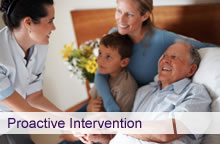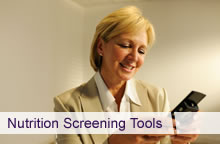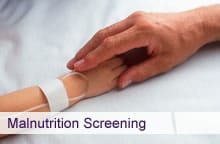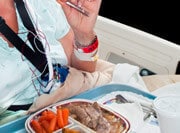Protein-calorie malnutrition has been recognized as a nutritional problem in the healthcare setting since the mid 1970s, when research began to demonstrate that up to half of hospitalized patients were at risk for malnutrition (1) and up to 12% were severely malnourished. (2) Malnourished patients are hospitalized up to 100% longer than patients with comparable diagnoses who are well nourished, and expenses for malnourished patients average 75% higher than their well-nourished counterparts. (3)
Proactive Intervention
Proactive Intervention
A Hazard?
Can Nutrition Technology be a hazard to your hospital? Read more in the Real Time Blog
Healthcare experts recognize the role of proactive nutrition intervention in reducing morbidity and mortality, reducing length of stay and associated expenses, and most importantly, promoting quality of care and quality of life for individuals receiving medical care. While nutrition screening evolved as a means to identify protein-calorie malnutrition, today it has broad applications in identifying patients who can benefit from nutritional care.

Continually screening every patient’s nutritional risk and implementing proactive nutritional interventions on a timely basis are key to quality healthcare. This is why Joint Commission standards require nutrition screening within 24 hours of admission.
Nutrition Screening Practices
Nutrition Screening Practices Today

Nutrition Screening Criteria
Listed in order of popularity
- History of weight loss
- Poor intake prior to admission
- Patient is on nutrition support
- Chewing/swallowing issues
- Skin breakdown
- Pregnant/lactating
- Diagnosis
- Need for education
- Geriatric surgical patient
- Specific diet orders
- Food allergy
- NPO/clear liquid
- Weight for height criterion
- Age
- Visceral proteins (albumin, prealbumin)
- Infant on concentrated formula
- Body mass index
Source: Chima and colleagues.Nutrition Risk Screening in Acute Care: A Survey of Practice,August 2008
They also noted that 84% of survey respondents said that nursing staff carry primary responsibility for nutrition screening. However, respondents also said that nutrition staff repeat the nutrition screening due to issues such as patients being missed, nursing screenings not being done, or nutrition staff not being notified of positive nutrition risk screening results. Only 23% of nutrition screens were being documented in a computer-based medical record. These findings underscore the importance of automating nutrition risk screening, applying technology to ensure consistent applications and notification.
Using HL7 interfaces, the Nutritional Risk Screening Tool accepts data from hospital A/D/T, order entry, laboratory, and pharmacy systems. The screening reports show all patients in the hospital who meet the nutritional risk criteria established by the facility. Appropriate patient information (name, room number, diet type, diagnosis, etc.) is shown, as well as the specific risk criteria that have been met. This builds a set of real-time data.
The next step is to apply a model for analyzing data relevant to nutrition data. A variety of models exist. According to Chima and colleagues, “Because there is no national consensus or gold standard regarding nutrition risk, screening practice and criteria vary.”
Some systems use scoring, while others classify patients into one of two or three risk categories. Opportunities for enhanced nutrition informatics exist in that clinical outcomes from nutrition screening and support vary according to many other factors, such as age, severity of nutrition screening score, and diagnosis. (Kondrup and colleagues. Nutritional risk screening. NRS 2002: a new method based on an analysis of controlled clinical trials)
Nutrition Screening Tools
Nutrition Screening Tools

- Nutritional Risk Screening 2002 (NRS 2002) scores risk based on undernutrition and severity of disease. Scoring is on a scale of 1 to 6. A score of 3 is classified as nutritionally at-risk.
- Mini Nutritional Assessment (MNA) is a short questionnaire designed for use with the elderly.
- Malnutrition Screening Tool (MST) uses only two questions, addressing appetite and recent unintentional weight loss. Scoring is on a scale of 0 to 5, with 2 or more indicating nutrition risk.

Clinical nutrition staff can use the Vision Nutritional Risk Screening report to prioritize work. They can become more productive, performing assessments and creating care plans for patients who may benefit from their expertise and interventions. As part of quality of care and informatics initiatives, Vision Software provides electronic documentation of nutrition findings as well.
More Resources
References
- Bistrian BR, Blackburn GL, Vitale J, et al: Prevalence of malnutrition in general medical patients. JAMA 1976; 235:1567-1570.
- Detsky AS, Baker JP, O’Rourke K, Goel V: Perioperative parenteral nutrition: A meta-analysis. Ann Intern Med 1987; 107:195-203.
- Christensen KS: Hospitalwide screening increases revenue under prospective payment system. J Am Diet Assoc 1986;86 1234-1235.
- Christensen KS, Gstundtner KM: Hospital-wide screening improves basis for nutrition intervention. J Am Diet Assoc 1985; 85:704-706.








